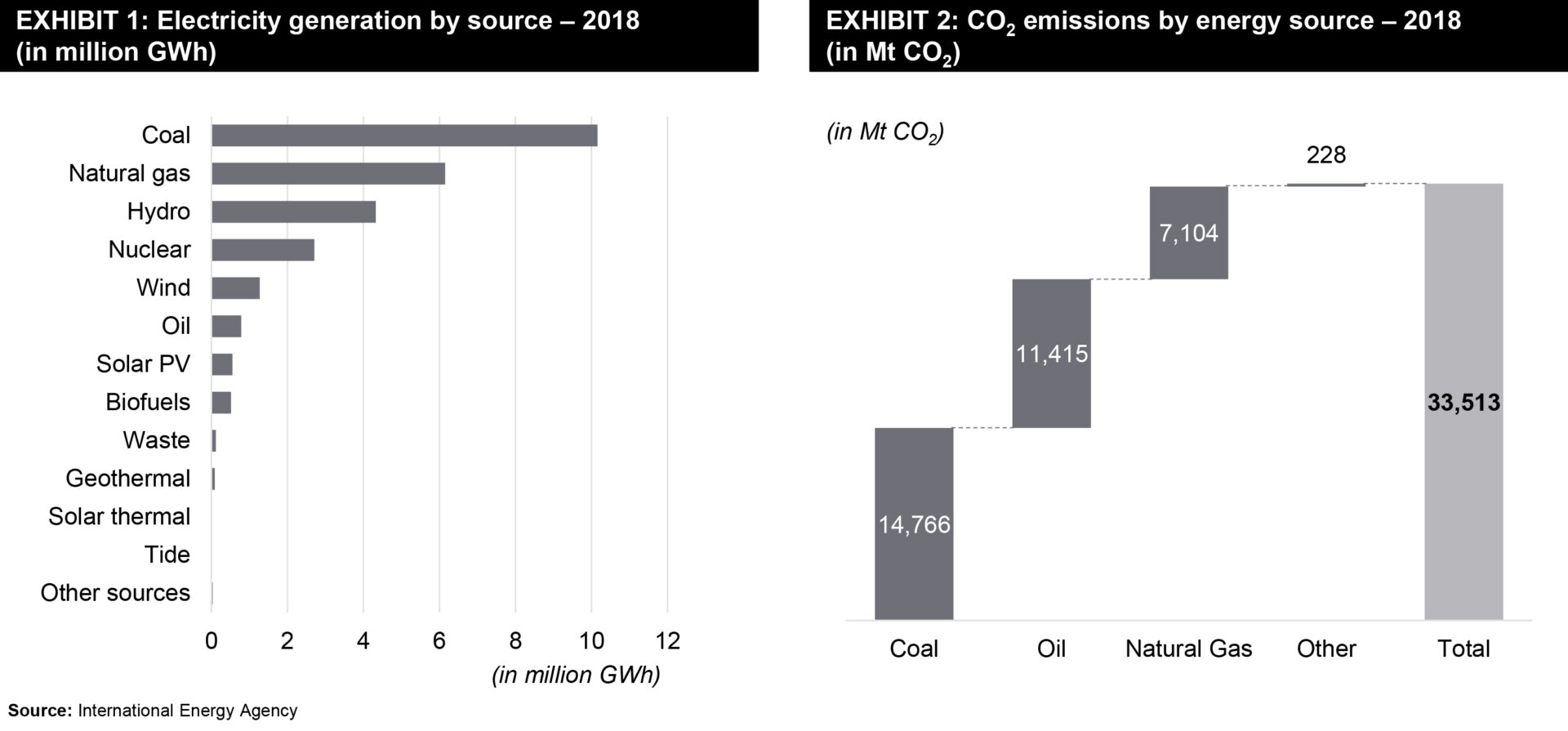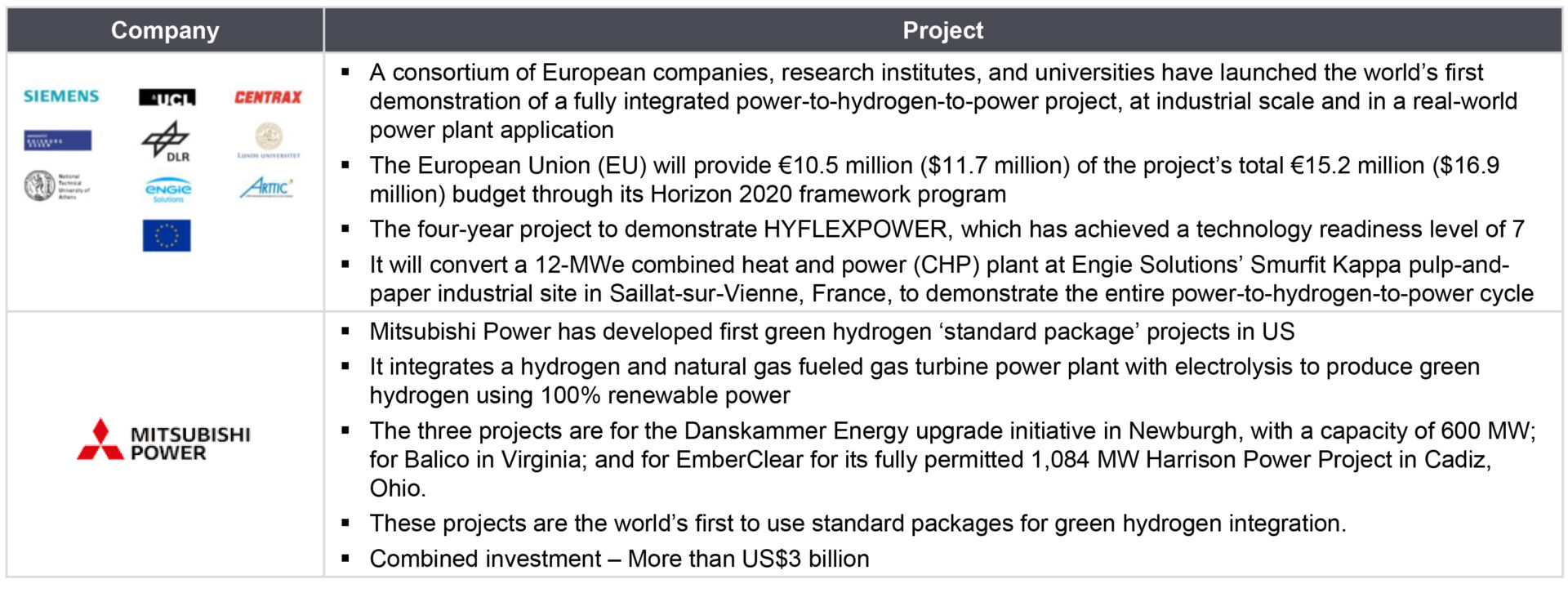Over the last few years, circumstances have conspired to create awareness for green energy. The factors which altered our paradigm of development include climate change, advances in renewable energy, and energy security. Decarbonization has become the central theme for developments in all sectors and the power sector is no exception to it.
Coal and natural gas are the major sources of electricity generation across the world. Coal is the primary source of power generation in developing countries while natural gas is used by developed countries to a larger extent. Both the resources cater to baseload demand while natural gas acts as a fuel for peak load plants also due to higher ramp up and ramp down rates. Exhibit 1 depicts global electricity generation by source in the year 2018 and Exhibit 2 depicts global CO2 emissions by energy source in the year 2018.


Coal, oil, and natural gas are the primary sources of CO2 emissions across the world. While emissions from oil are mainly attributed to vehicles, those from coal and natural gas are attributed to power generation. Thus, as a step towards reducing carbon emissions, decarbonization of the power generation sector is of utmost priority.
Countries across the world are rolling out policies to increase the penetration of renewable power in the energy mix. This has led to an impact on the conventional power generation sector and the threat to coal and natural gas-based power plants is increasing. It is important to note that conventional power plants need to change their business models to sustain. Certain policies and mandates make it necessary for them to do so.
Impact on Conventional Power Plants
As a transition towards green energy, some upstream processes in conventional power plants need to be altered. Gas turbines in thermal power plants have to be modified to use a blend of natural gas or steam and hydrogen to reduce carbon emissions. For doing so, a hydrogen plant has to be established at the plant location with due precautions of fuel line safety. To make the hydrogen generation carbon-free, electricity used for the electrolysis process can be used from renewable sources. Conventional power plants can earn revenue from the oxygen produced as a by-product of the hydrogen plant. The modifications in plants need retrofit of existing generation units and ancillary systems and companies may have to enter into a contract with EPC companies to carry out the transition. In house capability building also remains an option in the transition process. This will impact the operational and financial models of the company which needs to be looked at.
Increasing penetration of battery storage is a threat to natural gas-based peak power plants. The use of battery storage to cater to peak demand is being looked at as a greener option over natural gas-based plants. These power plants will face gradual phasing out and alternative applications of such peak plants may be found out. There is an option of harnessing the components in the plant after salvage.
Another threat to conventional peak power plants is the emerging hydrogen fuel cells based power plant. Fuel cells are being considered to supply peak-load demand due to higher efficiency and higher ramping rate. Hanwha Energy has established a hydrogen-fuel-cell power plant that only uses recycled hydrogen in Korea. The 50 MW capacity plant has the ability to generate up to 400,000 MWh of electricity per year. These plants may eventually replace conventional peak load plants.
For coal-based thermal power plants, switch over to hydrogen blended power generation will cause loss of revenue which they were getting from the sale of fly ash for the construction and cement industry.
Developments and Case Studies
Many market players have entered into the new application area of hydrogen blended turbines. The following table depicts a few such key developments.


Projects using Hydrogen blended turbines are being deployed across the world. The following table lists two such examples.


Going Forward
Although the green transition will have a lot of economical, technical, and operational challenges in the conventional power plant sector, it is a process that needs to be followed in the future for the growth of environment-friendly power generation. Hydrogen blended turbines will play a key role in the decarbonization of the power generation sector. Both steam-based and natural gas-based conventional power plants can adopt hydrogen blended turbines. Multiple power equipment manufacturers are working on the development of turbines that can operate with a high volume of hydrogen.
Energy storage and fuel cells based power plants will remain an inevitable threat to conventional peak power plants. For example, the solar plus storage plant can compete with existing peak plants which can challenge the business case for building new peak plants or continue running the existing ones. Going forward, fuel cells will be a preferred green solution for supplying peak load.
Need a thought partner?
Share your focus area or question to engage with our Analysts through the Business Objectives service.
Submit My Business ObjectiveOur Clients
Our long-standing clients include some of the worlds leading brands and forward-thinking corporations.
- © 2021 Cheers Interactive (India) Private Limited. All rights reserved. FutureBridge ® is a registered trademark of Cheers Interactive (India) Private Limited.




































